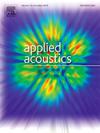轻型电动汽车加速过程噪声排放校正模型
IF 3.4
2区 物理与天体物理
Q1 ACOUSTICS
引用次数: 0
摘要
从轻型内燃机(ICE)车辆(如轿车和货车)到轻型电动汽车(ev)的转变为减少城市环境中的道路交通噪音暴露提供了机会,但这仍需要量化。尽管人们对轻型内燃机汽车(包括加速和减速过程)的噪音排放已经有了很好的了解,但迄今为止,对轻型电动汽车(尤其是加速过程)的噪音排放还没有进行彻底的研究。因此,本研究基于参考条件下的路过测量,提出了轻型电动汽车加速过程中噪声排放的校正模型。收集了6种车型在稳定速度和全加速状态下的数据。分析了这两种情况下噪声级的差异,建立了校正模型。这个修正模型在一个八度频带水平上考虑了速度和加速度。结果表明,在63 Hz和125 Hz频带,加速对轻型电动汽车的噪声排放没有影响,并且在20 km/h时,加速可能使轻型电动汽车的总a加权排放增加高达5 dBA。此外,分析表明,减速不会增加轻型电动汽车的噪音排放。这一贡献为将电动汽车特定的噪音排放整合到噪音暴露评估框架中铺平了道路,使人们能够更全面地了解向电动汽车过渡的潜在好处。本文章由计算机程序翻译,如有差异,请以英文原文为准。
A correction model for the noise emissions of light electric vehicles during acceleration
The transition from light internal combustion engine (ICE) vehicles, such as cars and vans, to light electric vehicles (EVs) presents an opportunity to reduce road traffic noise exposure in urban environments, which still needs to be quantified. Although the noise emissions of light ICE vehicles are generally well understood, including during acceleration and deceleration, the noise emitted by light EVs has so far not been studied as thoroughly, in particular during acceleration.
This study thus proposes a correction model for the noise emissions of light EVs during acceleration, based on pass-by measurements under reference conditions. Data were collected for 6 vehicle models at both steady speed and full acceleration. The difference in noise levels between these two conditions was analysed to develop the correction model.
This correction model accounts for both speed and acceleration at an octave-band level. The resulting model shows that acceleration has no impact on the noise emissions of light EVs in the 63 and 125 Hz octave bands, and that acceleration may increase the overall A-weighted emissions of a light EV by up to 5 dBA, at 20 km/h. Furthermore, the analysis suggests that deceleration does not increase noise emissions for light EVs.
This contribution paves the way for the integration of EV-specific noise emissions into noise exposure assessment frameworks, enabling a more comprehensive understanding of the potential benefits associated with the transition towards EVs.
求助全文
通过发布文献求助,成功后即可免费获取论文全文。
去求助
来源期刊

Applied Acoustics
物理-声学
CiteScore
7.40
自引率
11.80%
发文量
618
审稿时长
7.5 months
期刊介绍:
Since its launch in 1968, Applied Acoustics has been publishing high quality research papers providing state-of-the-art coverage of research findings for engineers and scientists involved in applications of acoustics in the widest sense.
Applied Acoustics looks not only at recent developments in the understanding of acoustics but also at ways of exploiting that understanding. The Journal aims to encourage the exchange of practical experience through publication and in so doing creates a fund of technological information that can be used for solving related problems. The presentation of information in graphical or tabular form is especially encouraged. If a report of a mathematical development is a necessary part of a paper it is important to ensure that it is there only as an integral part of a practical solution to a problem and is supported by data. Applied Acoustics encourages the exchange of practical experience in the following ways: • Complete Papers • Short Technical Notes • Review Articles; and thereby provides a wealth of technological information that can be used to solve related problems.
Manuscripts that address all fields of applications of acoustics ranging from medicine and NDT to the environment and buildings are welcome.
 求助内容:
求助内容: 应助结果提醒方式:
应助结果提醒方式:


